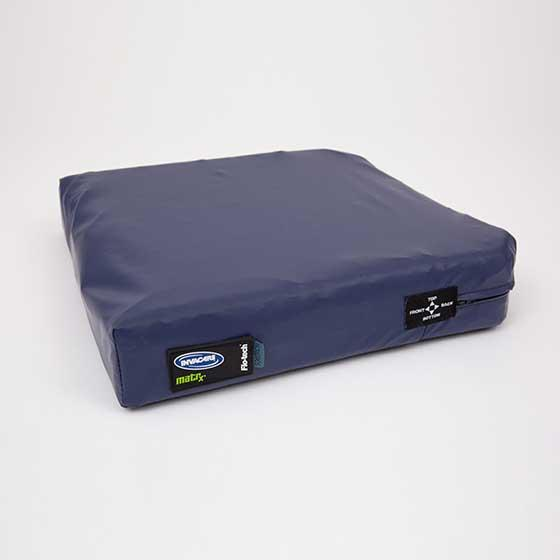Pressure sores are caused by prolonged pressure on the skin. The more immobile you are, and unable to actively change your position, the more likely you are to experience pressure damage to your skin. A gel cushion for wheelchairs has a significant role in proactive pressure care.
Moisture, heat and poor nutrition are three of the most common risk factors also for pressure damage although there are many more.
What you need to know is that not all gel cushions behave in the same way, have the same properties or offer the same level of protection. This is because Gel is a term used interchangeably whether made of a polymer or fluid. Gel is a Polymer, which is a semi-solid material with limited ability to conform to user’s body shape. Fluid has lower viscosity than a Polymer, allowing body immersion into to the materials and higher envelopment, which means better pressure redistribution. It also means that the fluid viscosity does not change and therefore the protection provided does not change regardless of the environment it is used in.
So what is the best way to reduce pressure whilst sat in a wheelchair for long periods?
A good way of reducing risk is to change your position regularly. For example, lifting a buttock off the surface of a chair will instantly alleviate the pressure on that body part. However, as many wheelchairs users cannot do this it is just as important to ensure you are sitting on the correct pressure reducing surface. This is when pressure cushions are really important in preventing pressure sores.
Gel cushions help reduce pressure in a number of ways:
Positioning:
Standard gel cushions change shape to accommodate your body shape. Although, initially this can be effective in standard flat non-shaped cushions users often report feeling unstable after prolonged seating.
The Invacare cushion range includes a number of models with fluid sacs which are often referred to as Gel cushions, and resolve this problem by pre-moulding the high density foam of their wheelchair cushions, to fit the contour of a user and placing the fluid sac or gel in the area it is most needed. A good example of this is the Matrx Flo-Tech image cushion.
In this case, the person needing the pressure care support is at greatest risk to the coccyx region. Therefore, Invacare’s gel section placed at the rear of the cushion reduces this risk. The contoured ergonomic design of the cushion also maintains stability, comfort and position for the seated person. Furthermore, the greatest area of pressure care placed only where it is most needed.
The Libra cushion in particular controls both static and dynamic shear.
Static: Supports the surface contour that prevents sliding and downward migration of the pelvis.
Dynamic: Flow of materials reduces tension between bony prominences and tissues during functional activities, wheelchair propulsion, accommodating movement within a specific range.
Both static and dynamic shear are controlled without compromising on posture.
The Fluid
The properties of Gel cushions for wheelchairs, as well as moulding to the contours of your body, remove heat and are naturally very cool. This is as important as heat and can lead to pressure areas. Therefore, removing this heat is vital.
Thickness
Your cushion needs to be thick enough. You could have all the gel and advanced design in the world, but if the cushion is too thin, you run the risk of bottoming out increasing pressure and not getting support from the cushion at all. The Invacare ranges of cushions come in different thicknesses to meet individual need based on your weight, body shape and risk.
Covers
Seat covers are also crucial in proactive pressure care. I’ve already said how heat and moisture play a part in increasing the risk of pressure ulcers. When you cover your cushion, the cover needs to be breathable and stretch to also fit with the contours of the body. Invacare design their cushion covers with multi-stretch materials that are breathable, reducing heat and moisture build up. These covers come in smooth, wipe down or spacer materials each having different clinical benefits depending on your needs.
In short, gel cushions for wheelchairs or a cushion with a gel like component such as the ‘fluid sac’ in the Invacare example, play a massive role in proactive pressure care as the fluid helps manage shear forces. The fluid also provides a cooling effect for those with temperature related issues which helps in the management of microclimate.
The seat cushion needs to fit the user as well as the wheelchair so that they become one entity working in collaboration.
A medical or healthcare profession should always be involved to determine risk and therefore guide you through the process.
